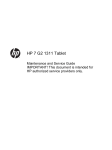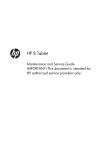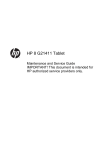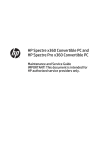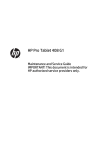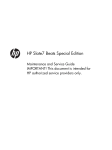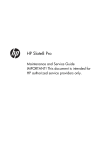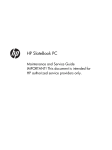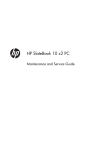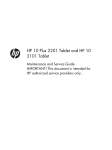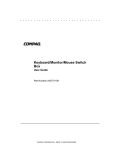Download HP 1302us Maintenance and Service Guide
Transcript
HP 7 Plus Tablet and HP 7.1 Tablet Maintenance and Service Guide IMPORTANT! This document is intended for HP authorized service providers only. © Copyright 2014 Hewlett-Packard Development Company, L.P. Bluetooth is a trademark owned by its proprietor and used by Hewlett-Packard Company under license. SD Logo is a trademark of its proprietor. The information contained herein is subject to change without notice. The only warranties for HP products and services are set forth in the express warranty statements accompanying such products and services. Nothing herein should be construed as constituting an additional warranty. HP shall not be liable for technical or editorial errors or omissions contained herein. First Edition: May 2014 Document Part Number: 768337-001 Product notice This guide describes features that are common to most models. Some features may not be available on your computer. Software terms By installing, copying, downloading, or otherwise using any software product preinstalled on this tablet, you agree to be bound by the terms of the HP End User License Agreement (EULA). If you do not accept these license terms, your sole remedy is to return the entire unused product (hardware and software) within 14 days for a refund subject to the refund policy of your place of purchase. For any further information or to request a full refund of the tablet, please contact your local point of sale (the seller). Safety warning notice WARNING! To reduce the possibility of heat-related injuries or of overheating the device, do not place the device directly on your lap or obstruct the device air vents. Use the device only on a hard, flat surface. Do not allow another hard surface, such as an adjoining optional printer, or a soft surface, such as pillows or rugs or clothing, to block airflow. Also, do not allow the AC adapter to contact the skin or a soft surface, such as pillows or rugs or clothing, during operation. The device and the AC adapter comply with the user-accessible surface temperature limits defined by the International Standard for Safety of Information Technology Equipment (IEC 60950). iii iv Safety warning notice Table of contents 1 Product description ........................................................................................................... 1 2 External component identification ..................................................................................... 3 3 Illustrated parts catalog .................................................................................................... 5 Locating the serial number, product number, and model number .................................................... 5 Tablet major components .......................................................................................................... 6 Miscellaneous parts .................................................................................................................. 7 Sequential part number listing .................................................................................................... 8 4 Removal and replacement preliminary requirements ...................................................... 10 Tools required ....................................................................................................................... 10 Service considerations ............................................................................................................ 10 Plastic parts ............................................................................................................ 10 Cables and connectors ............................................................................................ 10 Grounding guidelines ............................................................................................................. 11 Electrostatic discharge damage ................................................................................. 11 Packaging and transporting guidelines ....................................................... 12 Workstation guidelines .............................................................. 12 5 Removal and replacement procedures ............................................................................ 14 Tablet component replacement procedures ................................................................................ 14 Back cover ............................................................................................................................ 14 Battery .................................................................................................................................. 16 Antenna ................................................................................................................................ 17 Speaker ................................................................................................................................ 18 Rear-facing webcam ............................................................................................................... 19 Microphone .......................................................................................................................... 20 Front-facing webcam .............................................................................................................. 21 Power/volume button board .................................................................................................... 22 System board ........................................................................................................................ 23 v 6 Specifications .................................................................................................................. 26 7 Statement of Volatility .................................................................................................... 27 Non-volatile memory usage ..................................................................................................... 29 Questions and answers ........................................................................................................... 32 8 Power cord set requirements .......................................................................................... 33 Requirements for all countries .................................................................................................. 33 Requirements for specific countries and regions ......................................................................... 33 9 Recycling ........................................................................................................................ 35 Index ................................................................................................................................. 36 vi 1 Product description Category Description Product Name HP 7 Plus Tablet HP 7 Plus Tablet HP 7.1 Tablet x HP 7.1 Tablet x Processor AllWinner® A31S 1.00-GHz quad core soldered on-circuit (SOC) processor x Panel 7.0-in, (1024×600), IPS TouchScreen display panel with 5-point, capacitive touch x 7.0-in, (1024×600), TN TouchScreen display panel with 5-point, capacitive touch x x Graphics PowerVR SGX544MP2×8 core x x Memory Supports 1-GB DDR3 x x Mass storage Supports an 8-GB Nand Flash drive x x Audio and video Integrated, forward-facing speaker x x One microphone Supports MP3, WAV, Flac, and 3GP audio formats 2.0-MP, autofocus rear-facing webcam 0.3-MP, fixed-focus front-facing webcam Supports MOV, MPEG4, VOB, FLV, DAT, MKV, and PMP video formats Supports JPG, BMP, GIF, and PNG photo formats Sensor Accelerometer x x Wireless networking Integrated WiFi option: 802.11 b/g/n with 1 antenna x x External expansion Integrated micro SD Card Reader expandable to 32-GB x x Ports ● Audio: 3.5-mm headphone/microphone combo jack (supports North American-type headset only) x x ● Micro USB 2.0 (supports charging) 1 Category Description Power requirements Supports a 2800-mAh, Li-ion battery (non-removable), USB charging battery HP 7 Plus Tablet HP 7.1 Tablet x x Supports an HP 5V-2A, USB, AC adapter with duck head DC plug and localized cable plug support 2 Operating system Preinstalled: Android 4.2.2 (Android 4.3 if possible) x x Serviceability End user replaceable part: x x ● HP 5V-2A AC adapter ● USB cable ● Wired headset Chapter 1 Product description 2 External component identification Item Component Item Component (1) Micro SD Card Reader slot (6) Front-facing webcam (2) Microphone (7) Power button (3) Micro USB port (8) Volume control buttons (2) 3 4 Item Component Item Component (4) Audio-out (headphone)/Audio-in (microphone) jack (9) Speaker (5) Rear-facing webcam Chapter 2 External component identification 3 Illustrated parts catalog NOTE: HP continually improves and changes product parts. For complete and current information on supported parts for your computer, go to http://partsurfer.hp.com, select your country or region, and then follow the on-screen instructions. Locating the serial number, product number, and model number The serial number (1), product name (2), product model (3), and product number (4) of your tablet are located on the bottom edge of the tablet. You may need this information when you travel internationally or when you contact support. Locating the serial number, product number, and model number 5 Tablet major components 6 Item Component (1) Back cover: Spare part number For use only on HP 7 Plus Tablet models 762205-001 For use only on HP 7.1 Tablet models 762207-001 (2) Battery, 3.7-V, 2800-mAh, Li-ion (includes cables) 775000-001 (3) Antenna Kit (includes wireless antenna transceiver and cable) 774998-001 (4) Microphone (includes cable) 773135-001 (5) 0.3-MP front-facing webcam (includes cable and double-sided adhesive): 775003-001 (6) Speaker (includes speaker and cables) 775004-001 (7) 2.0-MP rear-facing webcam for use on all tablet models (includes cable) 753193-001 (8) System board equipped with an AllWinner A31S 1.00-GHz quad core processor, 1.0-GB LP-DDR2 system memory and an 8.0-GB Nand flash drive 775001-001 (9) Power/volume button board (includes cable) 774999-001 (10) Display panel assembly (includes display panel cable and TouchScreen cable): Chapter 3 Illustrated parts catalog Item Component Spare part number 7-in., LCD, TouchScreen IPS display panel assembly for use only on HP 7 Plus Tablet models 775002-001 7-in., LCD, TouchScreen TN display panel assembly for use only on HP 7.1 Tablet models 775010-001 Miscellaneous parts Component Spare part number 0.3-W, 240-W, 50/60-Hz, 5.0-V, 2-A AC adapter: For use only on HP 7 Plus Tablet models in Argentina 757042-001 For use on all tablet models in Australia 757043-001 For use only on HP 7.1 Tablet models in Brazil 761437-001 For use on all tablet models in Europe 747779-001 For use only on HP 7 Plus Tablet models in India 757282-001 For use on all tablet models in North America 745229-001 For use on all tablet models in the People's Republic of China 757280-001 For use on all tablet models in the United Kingdom 747780-001 Tablet: HP 7 Plus Tablet equipped with a 7-in., LCD, TouchScreen IPS display, an AllWinner A31S 1.00GHz quad core processor, 1.0-GB LP-DDR2 system memory, and an 8.0-GB Nand flash drive 761952-001 HP 7 Plus Tablet equipped with a 7-in., LCD, TouchScreen IPS display, an AllWinner A31S 1.00GHz quad core processor, 1.0-GB LP-DDR2 system memory, and an 8.0-GB Nand flash drive for use as the Bank of Communication Tablet model 775006-001 HP 7 Plus Tablet equipped with a 7-in., LCD, TouchScreen IPS display, an AllWinner A31S 1.00GHz quad core processor, 1.0-GB LP-DDR2 system memory, and an 8.0-GB Nand flash drive 775005-001 HP 7.1 Tablet equipped with a 7-in., LCD, TouchScreen IPS display, an AllWinner A31S 1.00GHz quad core processor, 1.0-GB LP-DDR2 system memory, and an 8.0-GB Nand flash drive 761946-001 HP 7.1 Tablet equipped with a 7-in., LCD, TouchScreen IPS display, an AllWinner A31S 1.00GHz quad core processor, 1.0-GB LP-DDR2 system memory, and an 8.0-GB Nand flash drive 775011-001 Screw Kit 754941-001 USB extension cable 779120-001 Miscellaneous parts 7 Sequential part number listing 8 Spare part number Description 745229-001 0.3-W, 240-W, 50/60-Hz, 5.0-V, 2-A AC adapter for use on all tablet models in North America 747779-001 0.3-W, 240-W, 50/60-Hz, 5.0-V, 2-A AC adapter for use on all tablet models in Europe 747780-001 0.3-W, 240-W, 50/60-Hz, 5.0-V, 2-A AC adapter for use on all tablet models in the United Kingdom 753193-001 2.0-MP rear-facing webcam (includes cable) 754941-001 Screw Kit 757042-001 0.3-W, 240-W, 50/60-Hz, 5.0-V, 2-A AC adapter for use only on HP 7 Plus Tablet models in Argentina 757043-001 0.3-W, 240-W, 50/60-Hz, 5.0-V, 2-A AC adapter for use on all tablet models in Australia 757280-001 0.3-W, 240-W, 50/60-Hz, 5.0-V, 2-A AC adapter for use on all tablet models in the People's Republic of China 757282-001 0.3-W, 240-W, 50/60-Hz, 5.0-V, 2-A AC adapter for use only on HP 7 Plus Tablet models in India 761437-001 0.3-W, 240-W, 50/60-Hz, 5.0-V, 2-A AC adapter for use only on HP 7.1 Tablet models in Brazil 761946-001 HP 7.1 Tablet equipped with a 7-in., LCD, TouchScreen TN display, an AllWinner A31S 1.00-GHz quad core processor, 1.0-GB LP-DDR2 system memory, and an 8.0-GB Nand flash drive 761952-001 HP 7 Plus Tablet equipped with a 7-in., LCD, TouchScreen TN display, an AllWinner A31S 1.00GHz quad core processor, 1.0-GB LP-DDR2 system memory, and an 8.0-GB Nand flash drive 762205-001 Back cover for use only on HP 7 Plus Tablet models 762207-001 Back cover for use only on HP 7.1 Tablet models 773135-001 Microphone (includes cable) 774998-001 Antenna Kit (includes wireless antenna transceiver and cable) 774999-001 Power/volume button board 775000-001 Battery, 3.7-V, 2800-mAh, Li-ion (includes cables) 775001-001 System board equipped with an AllWinner A31S 1.00-GHz quad core processor, 1.0-GB LP-DDR2 system memory and an 8.0-GB Nand flash drive 775002-001 7-in., LCD, TouchScreen IPS display panel assembly for use only on HP 7 Plus Tablet models 775003-001 0.3-MP front-facing webcam (includes cable and double-sided adhesive) 775004-001 Speaker (includes speaker and cables) 775005-001 HP 7 Plus Tablet equipped with a 7-in., LCD, TouchScreen TN display, an AllWinner A31S 1.00GHz quad core processor, 1.0-GB LP-DDR2 system memory, and an 8.0-GB Nand flash drive 775006-001 HP 7 Plus Tablet equipped with a 7-in., LCD, TouchScreen TN display, an AllWinner A31S 1.00GHz quad core processor, 1.0-GB LP-DDR2 system memory, and an 8.0-GB Nand flash drive for use as the Bank of Communication Tablet model 775010-001 7-in., LCD, TouchScreen TN display panel assembly for use only on HP 7.1 Tablet models Chapter 3 Illustrated parts catalog Spare part number Description 775011-001 HP 7.1 Tablet equipped with a 7-in., LCD, TouchScreen TN display, an AllWinner A31S 1.00-GHz quad core processor, 1.0-GB LP-DDR2 system memory, and an 8.0-GB Nand flash drive 779120-001 USB extension cable Sequential part number listing 9 4 Removal and replacement preliminary requirements Tools required You will need the following tools to complete the removal and replacement procedures: ● Magnetic screw driver ● Phillips P0 screw driver ● Plastic case utility tool ● Torx T5 screw driver Service considerations The following sections include some of the considerations that you must keep in mind during disassembly and assembly procedures. NOTE: As you remove each subassembly from the tablet, place the subassembly (and all accompanying screws) away from the work area to prevent damage. Plastic parts CAUTION: Using excessive force during disassembly and reassembly can damage plastic parts. Use care when handling the plastic parts. Apply pressure only at the points designated in the maintenance instructions. Cables and connectors CAUTION: When servicing the tablet, be sure that cables are placed in their proper locations during the reassembly process. Improper cable placement can damage the tablet. Cables must be handled with extreme care to avoid damage. Apply only the tension required to unseat or seat the cables during removal and insertion. Handle cables by the connector whenever possible. In all cases, avoid bending, twisting, or tearing cables. Be sure that cables are routed in such a way that they cannot be caught or snagged by parts being removed or replaced. Handle flex cables with extreme care; these cables tear easily. 10 Chapter 4 Removal and replacement preliminary requirements Grounding guidelines Electrostatic discharge damage Electronic components are sensitive to electrostatic discharge (ESD). Circuitry design and structure determine the degree of sensitivity. Networks built into many integrated circuits provide some protection, but in many cases, ESD contains enough power to alter device parameters or melt silicon junctions. A discharge of static electricity from a finger or other conductor can destroy static-sensitive devices or microcircuitry. Even if the spark is neither felt nor heard, damage may have occurred. An electronic device exposed to ESD may not be affected at all and can work perfectly throughout a normal cycle. Or the device may function normally for a while, then degrade in the internal layers, reducing its life expectancy. CAUTION: To prevent damage to the tablet when you are removing or installing internal components, observe these precautions: Keep components in their electrostatic-safe containers until you are ready to install them. Before touching an electronic component, discharge static electricity by using the guidelines described in this section. Avoid touching pins, leads, and circuitry. Handle electronic components as little as possible. If you remove a component, place it in an electrostatic-safe container. The following table shows how humidity affects the electrostatic voltage levels generated by different activities. CAUTION: A product can be degraded by as little as 700 V. Typical electrostatic voltage levels Relative humidity Event 10% 40% 55% Walking across carpet 35,000 V 15,000 V 7,500 V Walking across vinyl floor 12,000 V 5,000 V 3,000 V Motions of bench worker 6,000 V 800 V 400 V Removing DIPS from plastic tube 2,000 V 700 V 400 V Removing DIPS from vinyl tray 11,500 V 4,000 V 2,000 V Removing DIPS from Styrofoam 14,500 V 5,000 V 3,500 V Removing bubble pack from PCB 26,500 V 20,000 V 7,000 V Packing PCBs in foam-lined box 21,000 V 11,000 V 5,000 V Grounding guidelines 11 Packaging and transporting guidelines Follow these grounding guidelines when packaging and transporting equipment: ● To avoid hand contact, transport products in static-safe tubes, bags, or boxes. ● Protect ESD-sensitive parts and assemblies with conductive or approved containers or packaging. ● Keep ESD-sensitive parts in their containers until the parts arrive at static-free workstations. ● Place items on a grounded surface before removing items from their containers. ● Always be properly grounded when touching a component or assembly. ● Store reusable ESD-sensitive parts from assemblies in protective packaging or nonconductive foam. ● Use transporters and conveyors made of antistatic belts and roller bushings. Be sure that mechanized equipment used for moving materials is wired to ground and that proper materials are selected to avoid static charging. When grounding is not possible, use an ionizer to dissipate electric charges. Workstation guidelines Follow these grounding workstation guidelines: 12 ● Cover the workstation with approved static-shielding material. ● Use a wrist strap connected to a properly grounded work surface and use properly grounded tools and equipment. ● Use conductive field service tools, such as cutters, screw drivers, and vacuums. ● When fixtures must directly contact dissipative surfaces, use fixtures made only of staticsafe materials. ● Keep the work area free of nonconductive materials, such as ordinary plastic assembly aids and Styrofoam. ● Handle ESD-sensitive components, parts, and assemblies by the case or PCM laminate. Handle these items only at static-free workstations. ● Avoid contact with pins, leads, or circuitry. ● Turn off power and input signals before inserting or removing connectors or test equipment. Chapter 4 Removal and replacement preliminary requirements Equipment guidelines Grounding equipment must include either a wrist strap or a foot strap at a grounded workstation. ● When seated, wear a wrist strap connected to a grounded system. Wrist straps are flexible straps with a minimum of one megohm ±10% resistance in the ground cords. To provide proper ground, wear a strap snugly against the skin at all times. On grounded mats with banana-plug connectors, use alligator clips to connect a wrist strap. ● When standing, use foot straps and a grounded floor mat. Foot straps (heel, toe, or boot straps) can be used at standing workstations and are compatible with most types of shoes or boots. On conductive floors or dissipative floor mats, use foot straps on both feet with a minimum of one megohm resistance between the operator and ground. To be effective, the conductive must be worn in contact with the skin. The following grounding equipment is recommended to prevent electrostatic damage: ● Antistatic tape ● Antistatic smocks, aprons, and sleeve protectors ● Conductive bins and other assembly or soldering aids ● Nonconductive foam ● Conductive tabletop workstations with ground cords of one megohm resistance ● Static-dissipative tables or floor mats with hard ties to the ground ● Field service kits ● Static awareness labels ● Material-handling packages ● Nonconductive plastic bags, tubes, or boxes ● Metal tote boxes ● Electrostatic voltage levels and protective materials The following table lists the shielding protection provided by antistatic bags and floor mats. Material Use Voltage protection level Antistatic plastics Bags 1,500 V Carbon-loaded plastic Floor mats 7,500 V Metallized laminate Floor mats 5,000 V Grounding guidelines 13 5 Removal and replacement procedures NOTE: HP continually improves and changes product parts. For complete and current information on supported parts for your computer, go to http://partsurfer.hp.com, select your country or region, and then follow the on-screen instructions. Tablet component replacement procedures CAUTION: Tablet components described in this chapter should only be accessed by an authorized service provider. Accessing these parts can damage the tablet and void the warranty. This chapter provides removal and replacement procedures for authorized service provider only parts. There are as many as 6 screws that must be removed, replaced, and/or loosened when servicing the tablet. Make special note of each screw size and location during removal and replacement. Back cover Description Spare part number For use only on HP 7 Plus Tablet models 762205-001 For use only on HP 7.1 Tablet models 762207-001 7-in., LCD, TouchScreen IPS display panel assembly for use only on HP 7 Plus Tablet models 775002-001 7-in., LCD, TouchScreen TN display panel assembly for use only on HP 7.1 Tablet models 775010-001 Before disassembling the tablet, follow these steps: 1. Turn off the tablet. If you are unsure whether the tablet is off or in Hibernation, turn the tablet on, and then shut it down through the operating system. 2. Disconnect the power from the tablet by unplugging the power cord from the tablet. 3. Disconnect all external devices from the tablet. Remove the back cover: 14 Chapter 5 Removal and replacement procedures CAUTION: Before positioning the tablet with the display panel facing down, make sure the work surface is clear of tools, screws, and any other foreign objects. Failure to follow this caution can result in damage to the display panel assembly. 1. Place the tablet on a flat surface, display panel side down, with the power button and volume buttons toward you. 2. Remove the four Torx5 T5M1.4×4.0 screws that secure the back cover to the display panel assembly. 3. Turn the tablet display side up, with the power button and volume buttons toward you. 4. Insert a plastic case utility tool (1) or similar thin, plastic tool into the top edge of the tablet between the back cover and the display panel assembly. 5. Lift the top edge of the display panel assembly (2) and swing it up and to the left until it separates from the back cover. Back cover 15 6. Remove the display panel assembly (3) from the back cover. Reverse this procedure to install the back cover. Battery Description Spare part number Battery, 3.7-V, 2800-mAh, Li-ion (includes cables) 775000-001 Before removing the battery, follow these steps: 1. Turn off the tablet. If you are unsure whether the tablet is off or in Hibernation, turn the tablet on, and then shut it down through the operating system. 2. Disconnect the power from the tablet by unplugging the power cord from the tablet. 3. Disconnect all external devices from the tablet. 4. Remove the back cover (see Back cover on page 14). WARNING! To reduce potential safety issues, use only the battery provided with the tablet, a replacement battery provided by HP, or a compatible battery purchased from HP. CAUTION: Removing a battery that is the sole power source for the tablet can cause loss of information. To prevent loss of information, save your work or shut down the tablet through Windows before removing the battery. Remove the battery: 16 Chapter 5 Removal and replacement procedures CAUTION: Before positioning the tablet with the display panel facing down, make sure the work surface is clear of tools, screws, and any other foreign objects. Failure to follow this caution can result in damage to the display panel assembly. 1. Place the display panel assembly on a flat surface, display panel side down, with the power button and volume buttons toward you. 2. Unsolder the battery cables from the terminals (1) on the system board. NOTE: When installing the battery, the battery red/yellow cable should be soldered to the system board “+” terminal, and the battery black cable should be soldered to the system board “-” terminal. 3. Remove the battery (2). Reverse this procedure to install the battery. Antenna Description Spare part number Antenna Kit (includes wireless antenna transceiver and cable) 774998-001 Before removing the antenna, follow these steps: 1. Turn off the tablet. If you are unsure whether the tablet is off or in Hibernation, turn the tablet on, and then shut it down through the operating system. 2. Disconnect the power from the tablet by unplugging the power cord from the tablet. 3. Disconnect all external devices from the tablet. 4. Remove the back cover (see Back cover on page 14). 5. Disconnect the battery cables from the system board (see Battery on page 16). Antenna 17 Remove the antenna: 1. Unsolder the antenna cable from the system board wireless terminal (1). 2. Release the antenna cable from the routing channel (2) between the battery and the system board. 3. Detach the antenna transceiver (3) from the display panel assembly. (The antenna transceiver is attached to the display panel assembly with double-sided adhesive.) 4. Remove the antenna transceiver and cable. Reverse this procedure to install the antenna. Speaker Description Spare part number Speaker (includes speaker and cables) 775004-001 Before removing the speaker, follow these steps: 18 1. Turn off the tablet. If you are unsure whether the tablet is off or in Hibernation, turn the tablet on, and then shut it down through the operating system. 2. Disconnect the power from the tablet by unplugging the power cord from the tablet. 3. Disconnect all external devices from the tablet. 4. Remove the back cover (see Back cover on page 14). 5. Disconnect the battery cables from the system board (see Battery on page 16). Chapter 5 Removal and replacement procedures Remove the speaker: 1. Unsolder the speaker cables (1) from the system board terminals. NOTE: When installing the speaker, the speaker red cable should be soldered to the system board “+” terminal, and the speaker black cable should be soldered to the “-” terminal. 2. Release the speaker cable (2) from the retention clip built into the display panel assembly. 3. Detach the speaker (3) from the display panel assembly. (The speaker is attached to the display panel assembly with double-sided adhesive.) 4. Remove the speaker. Reverse this procedure to install the speaker. Rear-facing webcam Description Spare part number 2.0-MP rear-facing webcam (includes cable) 753193-001 Before removing the rear-facing webcam, follow these steps: 1. Turn off the tablet. If you are unsure whether the tablet is off or in Hibernation, turn the tablet on, and then shut it down through the operating system. 2. Disconnect the power from the tablet by unplugging the power cord from the tablet. 3. Disconnect all external devices from the tablet. Rear-facing webcam 19 4. Remove the back cover (see Back cover on page 14). 5. Disconnect the battery cables from the system board (see Battery on page 16). Remove the rear-facing webcam: 1. Turn the system board upside down. 2. Release the zero insertion force (ZIF) connector (1) to which the rear-facing webcam is attached, and then disconnect the rear-facing webcam from the system board. 3. Remove the rear-facing webcam (2) and cable. Reverse this procedure to install the rear-facing webcam. Microphone Description Spare part number Microphone (includes cable) 773135-001 Before removing the microphone, follow these steps: 20 1. Turn off the tablet. If you are unsure whether the tablet is off or in Hibernation, turn the tablet on, and then shut it down through the operating system. 2. Disconnect the power from the tablet by unplugging the power cord from the tablet. 3. Disconnect all external devices from the tablet. 4. Remove the back cover (see Back cover on page 14). 5. Disconnect the battery cables from the system board (see Battery on page 16). Chapter 5 Removal and replacement procedures Remove the microphone: 1. Unsolder the microphone cables (1) from the system board terminals. NOTE: When installing the microphone, the microphone red cable should be soldered to the system board “+” terminal, and the microphone black cable should be soldered to the “-” terminal. 2. Release the microphone (2) from the retention molding built into the display panel assembly. 3. Remove the microphone and cable. Reverse this procedure to install the microphone. Front-facing webcam Description Spare part number 0.3-MP front-facing webcam (includes cable) 775003-001 Before removing the front-facing webcam, follow these steps: 1. Turn off the tablet. If you are unsure whether the tablet is off or in Hibernation, turn the tablet on, and then shut it down through the operating system. 2. Disconnect the power from the tablet by unplugging the power cord from the tablet. 3. Disconnect all external devices from the tablet. 4. Remove the back cover (see Back cover on page 14). 5. Disconnect the battery cables from the system board (see Battery on page 16). Front-facing webcam 21 Remove the front-facing webcam: 1. Release the ZIF connector (1) to which the front-facing webcam cable is attached, and then disconnect the front-facing webcam cable from the system board. 2. Release the front-facing webcam (2) from the retention molding built into the display panel assembly. 3. Remove the front-facing webcam and cable. Reverse this procedure to install the front-facing webcam. Power/volume button board Description Spare part number Power/volume button board (includes cable) 774999-001 Before removing the power/volume button board, follow these steps: 1. Turn off the tablet. If you are unsure whether the tablet is off or in Hibernation, turn the tablet on, and then shut it down through the operating system. 2. Disconnect the power from the tablet by unplugging the power cord from the tablet. 3. Disconnect all external devices from the tablet. 4. Remove the back cover (see Back cover on page 14). 5. Disconnect the battery cables from the system board (see Battery on page 16). Remove the power/volume button board: 1. 22 Release the ZIF connector (1) to which the power/volume button board cable is attached, and then disconnect the power/volume button board cable from the system board. Chapter 5 Removal and replacement procedures 2. Detach the power/volume button board (2) from the display panel assembly. (The power/volume button board is attached to the display panel assembly with double-sided adhesive. 3. Remove the power/volume button board and cable. Reverse this procedure to install the power/volume button board. System board Description Spare part number System board equipped with an AllWinner A31S 1.00-GHz quad core processor, 1.0-GB LPDDR2 system memory and an 8.0-GB Nand flash drive 775001-001 Before removing the system board, follow these steps: 1. Turn off the tablet. If you are unsure whether the tablet is off or in Hibernation, turn the tablet on, and then shut it down through the operating system. 2. Disconnect the power from the tablet by unplugging the power cord from the tablet. 3. Disconnect all external devices from the tablet. 4. Remove the back cover (see Back cover on page 14). 5. Disconnect the battery cable from the system board (see Battery on page 16). System board 23 Remove the system board: 1. Disconnect the following cables from the system board: (1) Front-facing webcam cable (see Front-facing webcam on page 21) (2) Microphone cable (see Microphone on page 20) (3) Power/volume button board cable (see Power/volume button board on page 22) (4) Release the ZIF connector to which the display panel cable is attached, and then disconnect the display panel cable from the system board (5) Release the ZIF connector to which the TouchScreen cable is attached, and then disconnect the TouchScreen cable from the system board (6) Speaker cable (see Speaker on page 18) 24 2. Remove the two Phillips PM1.4×2.75 screws (1) that secure the system board to the display panel assembly. 3. Remove the system board (2). Chapter 5 Removal and replacement procedures Reverse this procedure to install the system board. System board 25 6 Specifications Metric U.S. Width 12.2 cm 4.8 in Depth 0.8 cm 0.3 in Height 19.3 cm 7.6 in Weight (lowest weight configuration) 0.3 g 0.7 lb Dimensions Input power The tablet operates on DC power, which can be supplied by an AC or a DC power source. The AC power source must be rated at 100—240 V, 50/60 Hz. NOTE: The tablet can operate on DC power using an industry-standard micro-A or micro-B USB cable. The HP 5V 2A adapter included with your tablet is recommended for charging the tablet. Temperature Operating 5°C to 35°C 41°F to 95°F Nonoperating -20°C to 60°C -4°F to 140°F Relative humidity (non-condensing) Operating 10% to 90% Nonoperating 5% to 95% Maximum altitude (unpressurized) Operating -15 m to 3,048 m -50 ft to 10,000 ft Nonoperating -15 m to 12,192 m -50 ft to 40,000 ft NOTE: Applicable product safety standards specify thermal limits for plastic surfaces. The device operates well within this range of temperatures. 26 Chapter 6 Specifications 7 Statement of Volatility The purpose of this document is to provide general information regarding non-volatile memory in industry-standards based HP Business Notebook PC systems and provide general instructions for restoring nonvolatile memory that can contain personal data after the system has been powered off and the hard drive has been removed. HP Business Notebook PC products that use Intel-based or AMD®-based system boards contain volatile DDR memory. The amount of nonvolatile memory present in the system depends upon the system configuration. Intel-based and AMD-based system boards contain nonvolatile memory subcomponents as originally shipped from HP assuming that no subsequent modifications have been made to the system and assuming that no applications, features, or functionality have been added to or installed on the system. Following system shutdown and removal of all power sources from an HP Business Notebook PC system, personal data can remain on volatile system memory (DIMMs) for a finite period of time and will also remain in nonvolatile memory. The steps below will remove personal data from the notebook PC, including the nonvolatile memory found in Intel-based and AMD-based system boards. Some of these steps are disclosed in the Maintenance and Service Guides available for HP PC products available on the product support pages at www.hp.com. 1. Follow steps (a) through (I) below to restore the nonvolatile memory that can contain personal data. Restoring or re-programming nonvolatile memory that does not store personal data is neither necessary nor recommended. a. Enter BIOS (F10) Setup by powering on the system and pressing F10 when prompted near the bottom of the display, or press the ESC key to display the start up menu, then press F10 . If the system has a BIOS administrator password, enter the password at the prompt. b. Select the File menu, then Restore Defaults. c. Select the System Configuration menu, then Restore Security Defaults. d. If an asset or ownership tag is set, select the Security menu and scroll down to the Utilities menu. Select System IDs, and then select the tag that has been set. Press the spacebar once to clear the tag, then press Enter to return to the prior menu. e. If a DriveLock password is set, select the Security menu, scroll down to DriveLock, then select DriveLock password. Select the desired hard drive. Click Disable protection, enter the existing master DriveLock password, then press Enter to confirm and return to the prior menu. Repeat this procedure if more than one hard drive has a DriveLock password. 27 f. If an Automatic DriveLock password is set, select the Security menu, scroll down to Automatic DriveLock, then select the desired hard drive and disable protection. Repeat this procedure if more than one hard drive has an Automatic DriveLock password. g. Select the File menu, then Reset BIOS Security to factory default. Click yes at the warning message. h. Select the File menu, then Save Changes and Exit. i. Reboot the system. If the system has a Trusted Platform Module and/or fingerprint sensor, one or two prompts will appear: one to clear the TPM and the other to reset fingerprint sensor. Press F1 to accept or F2 to reject. If the HP notebook model number ends in a ‘p’ or ‘w’ and includes Intel Centrino with VProTM, reboot the PC and enter BIOS Setup by pressing F10 when prompted. Select System Configuration, then AMT Options. Then select Un-configure AMT on next boot. Select Save, then Yes. Select the File menu, and then select Save Changes and Exit. Reboot the system and confirm that you want to un-configure AMT. 2. j. If the optional Intel Anti-Theft Technology (AT) was activated, contact the provider to deactivate it. k. If the optional Absolute® Software Computrace® management and tracking service was activated on the notebook PC, contact the provider to deactivate it. l. Remove all power and system batteries for at least 24 hours. Remove and retain the storage drive or clear the contents of the drive. a. Hard Disk Drive (HDD) Clear the HDD contents by using the HP Disk Sanitizer® utility or a third party application that, ideally, is U.S. Department of Defense (DOD) 5220.22-M approved. To run HP Disk Sanitizer, enter BIOS Setup by powering on the system and pressing F10 when prompted near the bottom of the display, or press ESC to display the start up menu, then press F10. Select the Security menu and scroll down to the Utilities menu. Select Disk Sanitizer and select the desired drive. For a higher level of protection, select Optimum. NOTE: This process will take a long time, and the amount of time varies based on the hard drive capacity. b. Solid State Drive (SSD) Clear the SSD contents by using the BIOS Setup Secure Erase command option, or by using a third party utility designed to erase data from an SSD. To run Secure Erase, enter BIOS Setup by powering on the system and pressing F10 when prompted near the bottom of the display. Select the Security menu and scroll down to the Utilities menu. Select Secure Erase and select the desired hard drive. 28 Chapter 7 Statement of Volatility Non-volatile memory usage Non Volatile Memory Type Amount (Size) Does this memory store customer data? Does this memory retain data when power is removed? What is the purpose of this memory? How is data input into this memory? How is this memory write protected? Real Time Clock (RTC) battery backed-up CMOS configuration memory (CMOS) 256 Bytes No Yes Stores system date and time and limited keyboard controller data. Using the F10 Setup utility or changing the Microsoft Windows date and time. This memory is not writeprotected. HP recommends password protecting the F10 Setup utility. Controller (NIC) EEPROM 64 KBytes (not customer accessible) No Yes Store NIC configuration and NIC firmware. Using a utility from the NIC vendor that can be run from DOS. A utility is required to write data to this memory and is available from NIC vendor. Writing data to this ROM in an inappropriate manner will render the NIC nonfunctional. Keyboard ROM 64 KBytes (not customer accessible) No Yes Stores firmware code (keyboard, mouse, & battery management). Programmed at the factory. Code is updated when the system BIOS is updated. A utility is required for writing data to this memory and is available on the HP website. Writing data to this ROM in an inappropriate manner can render the PC nonfunctional. DIMM Serial Presence Detect (SPD) configuration data 256 Bytes per memory module, 128 Bytes programmable (not customer accessible) No Yes Stores memory module information. Programmed by the memory vendor. Data cannot be written to this memory when the module is installed in a PC. The specific write protection method varies by memory vendor. Non-volatile memory usage 29 30 Non Volatile Memory Type Amount (Size) Does this memory store customer data? Does this memory retain data when power is removed? What is the purpose of this memory? How is data input into this memory? How is this memory write protected? System BIOS 4 to 5 MBytes Yes Yes Store system BIOS code and PC configuration data. System BIOS code is programmed at the factory. Code is updated when the system BIOS is updated. Configuration data and settings are input using the F10 setup utility or a custom utility. A utility is required for writing data to this memory and is available on the HP website. Writing data to this ROM in an inappropriate manner can render the PC nonfunctional. Intel Management Engine Firmware (present only in models ending in a ‘p’ or ‘w’ or with Intel Centrino Pro technology) 1.5 or 5 MBytes Yes Yes Stores Management Engine Code, Settings, Provisioning Data and iAMT third party data store. Management Engine Code is programmed at the factory. Code is updated via Intel secure firmware update utility. Unique Provisioning Data can be entered at the factory or by an administrator using the Management Engine (MEBx) setup utility. The third party data store contents can populated by a remote management console or local applications registered by an administrator to have access to the space. The Intel chipset is configured to enforce hardware protection to block all direct read/write access to this area. An Intel utility is required for updating the firmware. Only firmware updates digitally signed by Intel can be applied using this utility. Chapter 7 Statement of Volatility Non Volatile Memory Type Amount (Size) Does this memory store customer data? Does this memory retain data when power is removed? What is the purpose of this memory? How is data input into this memory? How is this memory write protected? Bluetooth flash 2 MBits No Yes Stores Bluetooth configuration and firmware. Programmed at the factory. Tools for writing data to this memory are not publicly available but can be obtained from the silicon vendor. A utility is required for writing data to this memory and is made available through newer versions of the driver if the flash requires an upgrade. 802.11 WLAN EEPROM 4 KBytes to 8 KBytes No Yes Stores configuration and calibration data. Programmed at the factory. Tools for writing data to this memory are not made public. A utility is required for writing data to this memory and is typically not made available to the public unless a firmware upgrade is necessary to address a unique issue. Webcam 64 KBits No Yes Store webcam configuration and firmware. Using a utility from the device manufacturer that can be run from Windows. A utility is required for writing data to this memory and is typically not made available to the public unless a firmware upgrade is necessary to address a unique issue. Fingerprint reader 512 KBytes flash Yes Yes Stores fingerprint templates. By enrolling in HP ProtectTools Security Manager. Only a digitally signed application can make the call to write to the flash. Non-volatile memory usage 31 Questions and answers 1. 2. How can the BIOS settings be restored (returned to default settings)? a. Turn on or restart the computer and press F10 when prompted near the bottom of the display. b. Select File, then select Restore defaults. c. Follow the on-screen instructions. d. Select File, save changes and exit, then press Enter. What kind of configuration data is stored on the DIMM Serial Presence Detect (SPD) memory module? How would this data be written? The DIMM SPD memory contains information about the memory module such as size, serial number, data width, speed/timing, voltage and thermal information. This information is written by the module manufacturer and stored on an EEPROM. This EEPROM cannot be written to when the memory module is installed in a PC. Third party tools do exist that can write to the EEPROM when the memory module is not installed in a PC. There are various third party tools available to read SPD memory. 3. Does the “Firmware Hub for System BIOS” contain the BIOS program? Is this chip writable, and if so how? The Firmware Hub does contain the BIOS program and is writable. A utility is required to perform the write function. 4. In some PC systems, the Firmware Hub for System BIOS is a flash memory chip so that updates can be written by the customer. Is this true for these BIOS chips? Yes, they are flash memory chips. 5. What is meant by “Restore the nonvolatile memory found in Intel-based system boards?” This relates to clearing the Real Time Clock (RTC) CMOS memory that contains PC configuration data. 6. Does resetting the CMOS configuration memory return the PC back to factory defaults? The process of resetting the CMOS will return certain system settings to factory default but will not reset many of the system data and configuration defaults to their default settings. To return these system data and configuration defaults to default settings, refer to question and answer 1 and follow the instructions for returning the BIOS settings to factory defaults. 32 Chapter 7 Statement of Volatility 8 Power cord set requirements The wide-range input feature of the tablet permits it to operate from any line voltage from 100 to 120 volts AC, or from 220 to 240 volts AC. The 3-conductor power cord set included with the tablet meets the requirements for use in the country or region where the equipment is purchased. Power cord sets for use in other countries and regions must meet the requirements of the country or region where the tablet is used. Requirements for all countries The following requirements are applicable to all countries and regions: ● The length of the power cord set must be at least 1.0 m (3.3 ft) and no more than 2.0 m (6.5 ft). ● All power cord sets must be approved by an acceptable accredited agency responsible for evaluation in the country or region where the power cord set will be used. ● The power cord sets must have a minimum current capacity of 10 amps and a nominal voltage rating of 125 or 250 V AC, as required by the power system of each country or region. ● The appliance coupler must meet the mechanical configuration of an EN 60 320/IEC 320 Standard Sheet C13 connector for mating with the appliance inlet on the back of the tablet. Requirements for specific countries and regions Country/region Accredited agency Applicable note number Australia EANSW 1 Austria OVE 1 Belgium CEBC 1 Canada CSA 2 Denmark DEMKO 1 Finland FIMKO 1 France UTE 1 Requirements for all countries 33 34 Country/region Accredited agency Applicable note number Germany VDE 1 Italy IMQ 1 Japan METI 3 The Netherlands KEMA 1 Norway NEMKO 1 The People's Republic of China COC 5 South Korea EK 4 Sweden CEMKO 1 Switzerland SEV 1 Taiwan BSMI 4 The United Kingdom BSI 1 The United States UL 2 1. The flexible cord must be Type HO5VV-F, 3-conductor, 1.0-mm² conductor size. Power cord set fittings (appliance coupler and wall plug) must bear the certification mark of the agency responsible for evaluation in the country or region where it will be used. 2. The flexible cord must be Type SPT-3 or equivalent, No. 18 AWG, 3-conductor. The wall plug must be a two-pole grounding type with a NEMA 5-15P (15 A, 125 V) or NEMA 6-15P (15 A, 250 V) configuration. 3. The appliance coupler, flexible cord, and wall plug must bear a “T” mark and registration number in accordance with the Japanese Dentori Law. The flexible cord must be Type VCT or VCTF, 3-conductor, 1.00-mm² conductor size. The wall plug must be a two-pole grounding type with a Japanese Industrial Standard C8303 (7 A, 125 V) configuration. 4. The flexible cord must be Type RVV, 3-conductor, 0.75-mm² conductor size. Power cord set fittings (appliance coupler and wall plug) must bear the certification mark of the agency responsible for evaluation in the country or region where it will be used. 5. The flexible cord must be Type VCTF, 3-conductor, 0.75-mm² conductor size. Power cord set fittings (appliance coupler and wall plug) must bear the certification mark of the agency responsible for evaluation in the country or region where it will be used. Chapter 8 Power cord set requirements 9 Recycling When a non-rechargeable or rechargeable battery has reached the end of its useful life, do not dispose of the battery in general household waste. Follow the local laws and regulations in your area for battery disposal. HP encourages customers to recycle used electronic hardware, HP original print cartridges, and rechargeable batteries. For more information about recycling programs, see the HP Web site at http://www.hp.com/recycle. 35 Index A AC adapter, spare part numbers 7, 8 antenna removal 17 spare part number 6, 8, 17 Antenna Kit, spare part number 6, 8, 17 audio, product description 1 audio-in jack 4 audio-out jack 4 B back cover removal 14 spare part numbers 6, 8, 14 battery removal 16 spare part number 6, 8, 16 buttons power 3 volume control 3 C cables, service considerations 10 card reader slot 3 connectors, service considerations 10 D display panel assembly, spare part numbers 6, 8, 14 display panel, product description 1 E electrostatic discharge 11 equipment guidelines 13 36 Index external expansion, product description 1 microphone jack 4 model name 1 F front-facing webcam location 3 removal 21 spare part number 6, 8, 21 O operating system, product description 2 G graphics, product description grounding guidelines 11 guidelines equipment 13 grounding 11 packaging 12 transporting 12 workstation 12 1 H headphone jack 4 J jacks audio-in 4 audio-out 4 headphone 4 microphone 4 M mass storage device, product description 1 memory module, product description 1 microphone location 3 product description 1 removal 20 spare part number 6, 8, 20 P packaging guidelines 12 plastic parts, service considerations 10 ports, product description 1 power button 3 power cord, set requirements 33 power requirements, product description 2 power/volume button board removal 22 spare part number 6, 8, 22 processor, product description 1 product description audio 1 display panel 1 external expansion 1 graphics 1 mass storage 1 memory module 1 microphone 1 operating system 2 ports 1 power requirements 2 processors 1 product name 1 sensor 1 serviceability 2 video 1 wireless networking 1 product name 1 R rear-facing webcam location 4 removal 19 spare part number 6, 8, 19 S Screw Kit, spare part number 7, 8 sensor, product description 1 service considerations cables 10 connectors 10 plastic parts 10 serviceability, product description 2 speaker location 4 removal 18 spare part number 6, 8, 18 system board removal 23 spare part number 6, 8, 23 T tablet major components 6 spare part numbers 7, 8, 9 specifications 26 tools required 10 transporting guidelines 12 U USB extension cable, spare part number 7, 9 USB port 3 V video, product description 1 volume control buttons 3 W webcam removal 19, 21 spare part numbers 6, 8, 19, 21 wireless antenna removal 17 spare part number 6, 8, 17 wireless networking, product description 1 workstation guidelines 12 Index 37












































